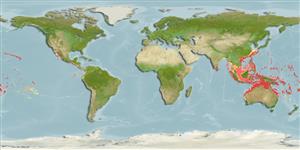Common names from other countries
>
Eupercaria/misc (Various families in series Eupercaria) >
Labridae (Wrasses) > Cheilininae
Etymology: Oxycheilinus: Greek, oxys = sharp + Greek, cheilos = lip.
Issue
Genus B. Mundy, pers. comm.
Environment: milieu / climate zone / depth range / distribution range
Ecologia
marinhas associadas(os) a recifes; intervalo de profundidade 0 - 160 m (Ref. 1602). Tropical; 30°N - 30°S
Eastern Indian Ocean and Pacific Ocean: Christmas Island in the eastern Indian Ocean to the Hawaiian, Marquesas and Tuamoto islands, north to the Ryukyu Islands, south to Rowley Shoals in northwestern Australia, New Caledonia, and Rapa.
Tamanho / Peso / Idade
Maturity: Lm ? range ? - ? cm
Max length : 46.0 cm TL macho/indeterminado; (Ref. 2334); peso máx. publicado: 1.4 kg (Ref. 2334)
Espinhos dorsais (total) : 9; Raios dorsais (total) : 10; Espinhos anais: 3; Raios anais : 8 - 11. Adults developing a distinctive black blotch covering the rears of the dorsal and anal fins (Ref. 37816). Display a bright white band over the tail (Ref. 48636). White bar often present on caudal peduncle (this pattern very changeable). Red lines radiating posteriorly from eye continuous across opercle to posterior opercular edge. Membranes of spinous portion of dorsal fin smooth, not incised (Ref 9823).
Usually solitary in coral rich areas of clear lagoon and seaward reefs. Hovers well above the bottom (Ref. 9710, 48636). Young secretive in soft corals and hydrozoans (Ref. 48636). Benthopelagic (Ref. 58302). Feeds mainly on fishes, shrimps and other crustaceans (Ref. 9823). May be ciguatoxic (Ref. 37816). Minimum depth reported taken from Ref. 128797.
Ciclo de vida ou comportamento de acasalamento
Maturities | Reprodução | Spawnings | Egg(s) | Fecundities | Larvas
Oviparous, distinct pairing during breeding (Ref. 205).
Westneat, M.W., 1993. Phylogenetic relationships of the tribe Cheilinini (Labridae: Perciformes). Bull. Mar. Sci. 52(1):351-394. (Ref. 7441)
Status na Lista Vermelha da UICN (Ref. 130435)
CITES (Ref. 128078)
Not Evaluated
Ameaça para os humanos
Reports of ciguatera poisoning (Ref. 4887)
Uso pelos humanos
Pescarias: pouco comercial; Aquário: Espécies comerciais
Ferramentas
Relatórios especiais
Baixar XML
Fontes da internet
Estimates based on models
Preferred temperature (Ref.
115969): 23.6 - 28.9, mean 27.3 (based on 690 cells).
Índice de diversidade filogenética (Ref.
82804): PD
50 = 0.5020 [Uniqueness, from 0.5 = low to 2.0 = high].
Bayesian length-weight: a=0.01585 (0.00707 - 0.03555), b=2.95 (2.76 - 3.14), in cm Total Length, based on LWR estimates for this (Sub)family-body shape (Ref.
93245).
Nível Trófico (Ref.
69278): 4.1 ±0.70 se; based on food items.
Resiliência (Ref.
120179): médio(a), tempo mínimo de duplicação da população 1,4 - 4,4 anos (Preliminary K or Fecundity.).
Fishing Vulnerability (Ref.
59153): Moderate vulnerability (36 of 100).
